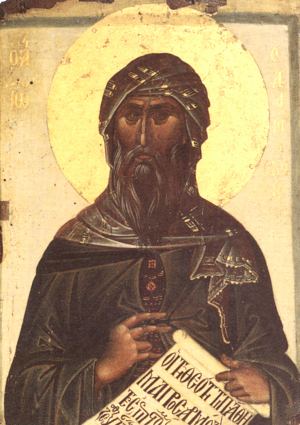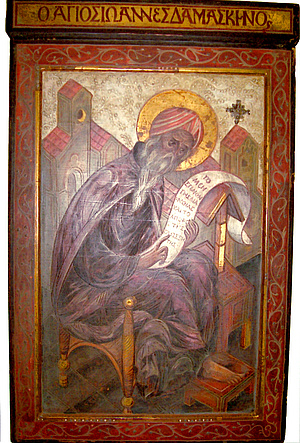
There are no contemporary sources documenting the life of John of Damascus who was born around 670 and died some time after 749 A.D. Since he was honoured as a saint already around 800 A.D., all biographies on John of Damascus written in Arabic and Greek since the 11th century, predominantly offer inspiring miracle stories and only little historically reliable material.
In contrast however, an early impact of his work is verified, especially of the writings defending the Byzantine veneration of icons: At the Council of Hieria (754), which endorsed the iconoclast position, he was namely condemned for heresy. When the veneration of icons asserted itself again shortly thereafter, the second Council of Nicaea (787) rehabilitated John of Damascus and declared the Hieria resolutions null and void. Ever since, John of Damascus is considered the last great Church Father and his work the especially orthodox account of a great Church Fathers tradition of teachings, the end of which John of Damascus stands for.
A Christian Civil Servant to a Muslim Regime

John was born Manṣūr b. Sarǧūn into an Arab-Christian family around 670 A.D. in Damascus. He was named after his grandfather, who had served as a tax official in Damascus under the Byzantine emperor Maurikios (582-602) and also held a high post in finance management under the Persian rule (612-628). Although the Byzantine emperor Herakleios (610-642) punished him after recapturing the city he was allowed to remain in office.
John’s grandfather also retained his professional status, when Damascus came under the influence of the Muslim Arabian empire in 635. His son Sarǧūn b. Manṣūr eventually took over the father’s position. According to the sources Sarǧūn b. Manṣūr supposedly maintained an especially close relationship with Caliph ‛Abd al-Malik, who from 685 until 705 reigned over Damascus, which in 661 had become the base of the ruling Omayyad dynasty.
Manṣūr b. Sarǧūn, later John of Damascus, probably became assistant to his father and later his successor in office during the reign of Caliph ‛Abd al-Malik. How long Manṣūr b. Sarǧūn served as a tax official can only be inferred from indications: During the reign of Caliph al-Walīd I. (705-715) Christians in his service were under increasing pressure to convert to Islam. Eventually this pressure intensified under ‛Umar II. (717-720) and finally resulted in a full Arabization of the state chancellery as well as in displacing Greek as the official language still in use.
Entering the Monastery
Although Manṣūr b. Sarǧūn doubtlessly knew how to read and write Arabic, there is some evidence that in the wake of the above mentioned changes he quit his service in Damascus between 705 and 720 and withdrew into a monastery near Jerusalem, receiving the monk’s name of John. In the monastery, he authored his comprehensive theological oeuvre, while, in his own understanding, he did not say anything new but wanted to summarise the proven und dogmatically impeccable instead.
His treatises in defence of the veneration of icons made him the iconolatry expert per se. His exposition of the right faith became a much-noticed reference for numerous theological issues and also spread into the Latin West.
